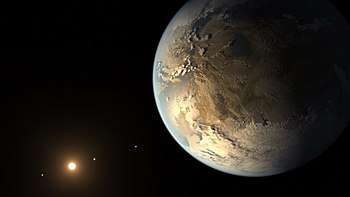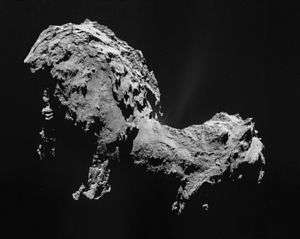WASP-104b
WASP-104b is a hot Jupiter exoplanet that orbits the star WASP-104.[2] It is considered to be one of the darkest exoplanets discovered.[3][4] WASP-104b was discovered in 2014; according to a 2018 study at Keele University, the planet's dense atmosphere of potassium and sodium absorbs more than 97% of light it receives.[3]
| Orbital characteristics | |
|---|---|
| Star | WASP-104 |
| Physical characteristics | |
Mean radius | ≈79488.807 km (1.137 greater than Jupiter's)[1] RJ |
| Mass | ≈2.4144 x 10^27 kg (1.272 greater than Jupiter's)[1] MJ |
| 1.8[1] | |
Characteristics
Darkness potential
Researchers have considered WASP-104b to be one of the darkest exoplanets ever discovered.[3][5] In 2018, scientists from Keele University said the exoplanet's thick sodium and potassium atmosphere can absorb more than 97% of the light that falls on it.[3] A paper published by Cornell University Library describes the exoplanet as "darker than charcoal" and "one of the least reflective planets found to date".[3][6] The only other two exoplanets thought to be darker than WASP-104b are TrES-2b and WASP-12b.[3] Its reflectance has been compared with that of WASP-12b, which absorbs 94% of the light it receives.[7]
Size, radius, and temperature
WASP-104b's size is comparable to that of Jupiter; its mass and radius are 1.272 times and 1.137 times greater than Jupiter's, respectively.[1] It has 12.5 times the mass of Earth and a low density, and may be composed of gas.[1]
Orbit and host star
WASP-104b is the only known exoplanet to orbit WASP-104, a 3-billion-year-old G8 star. WASP-104b's orbital period is 1.8 days; it is located 2.6 million miles from its star and has an orbital radius of 0.02918 astronomical units (2,712,000 mi).[8][1] WASP-104 and its planet are located 466 light years away from the Sun in the constellation Leo.[1][3][8]
References
- "WASP-104b". Exoplanet Exploration. 2014.
- Smith, A. M. S.; et al. (2014). "WASP-104b and WASP-106b: Two transiting hot Jupiters in 1.75-day and 9.3-day orbits". Astronomy and Astrophysics. 570. A64. arXiv:1408.0887. Bibcode:2014A&A...570A..64S. doi:10.1051/0004-6361/201424752.
- Lozovschi, Alexandra (23 April 2018). "'Darker Than Coal': Researchers Find A 'Hot Jupiter' That Absorbs Nearly 99 Percent Of Light". Inquisitr.
- "Distant Jupiter-like world may be the darkest planet ever found". New Scientist. 20 April 2018.
- Hignett, Katherine (23 April 2018). "Wasp-104b: Hot Jupiter Could Be Darkest Planet Ever Discovered". Newsweek.
- Močnik, T.; Hellier, C.; Southworth, J. (2018). "WASP-104b is Darker Than Charcoal". The Astronomical Journal. 156 (2). 44. arXiv:1804.05334. Bibcode:2018AJ....156...44M. doi:10.3847/1538-3881/aacb26.
- Jean-Pierre Chigne (24 April 2018). "WASP-104b Hot Jupiter Traps Nearly 99 Percent Of Light: What Is A Hot Jupiter And How Does It Form?". TechTimes.
- "WASP-104 b". Exoplanet Data Explorer.


